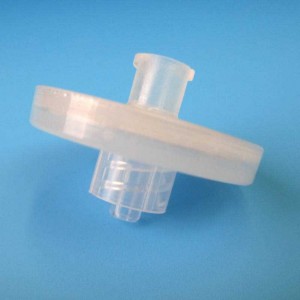 PTFE was accidentally invented by Roy Plunkett of Kinetic Chemicals in New Jersey in 1938. While Plunkett was attempting to make a new CFC refrigerant, the perfluorethylene polymerized in its pressurized storage container, with the iron from the inside of the container acting as a catalyst. Kinetic Chemicals patented it in 1941 and registered the PTFE trademark in 1945.
PTFE was accidentally invented by Roy Plunkett of Kinetic Chemicals in New Jersey in 1938. While Plunkett was attempting to make a new CFC refrigerant, the perfluorethylene polymerized in its pressurized storage container, with the iron from the inside of the container acting as a catalyst. Kinetic Chemicals patented it in 1941 and registered the PTFE trademark in 1945. 
Tisch PTFE syringe filter
By 1950, DuPont had acquired interest in Kinetic Chemicals and was producing over a million pounds (450 tons) of PTFE per year in Parkersburg, West Virginia. In 1954, French engineer Marc Grégoire created the first pan coated with PTFE non-stick resin under the brand name of Tefal after his wife urged him to try the material he had been using on fishing tackle on her cooking pans. In the United States, Kansas City, Missouri resident Marion A. Trozzolo, who had been using the substance on scientific utensils, marketed the first US-made PTFE coated frying pan, “The Happy Pan,” in 1961.
An early advanced use was in the Manhattan Project as a material to coat valves and seals in the pipes holding highly reactive uranium hexafluoride at the vast K-25 uranium enrichment plant at Oak Ridge, Tennessee.
PTFE is a thermoplastic polymer, which is a white solid at room temperature, with a density of about 2.2 g/cm3. According to DuPont, its melting point is 327 °C (621 °F), but its properties degrade above 260 °C (500 °F). PTFE gains its properties from the aggregate effect of carbon-fluorine bonds, as do all fluorocarbons.
The coefficient of friction of plastics is usually measured against polished steel. PTFE’s coefficient of friction is 0.1 or less, which is the second-lowest of any known solid material (diamond-like carbon being the first). PTFE’s resistance to van der Waals forces means that it is the only known surface to which a gecko cannot stick.
PTFE has excellent dielectric properties. This is especially true at high radio frequencies, making it suitable for use as an insulator in cables and connector assemblies and as a material for printed circuit boards used at microwave frequencies. Combined with its high melting temperature, this makes it the material of choice as a high-performance substitute for the weaker and lower melting point polyethylene that is commonly used in low-cost applications. Its extremely high bulk resistivity makes it an ideal material for fabricating long-life electrets, useful devices that are the electrostatic analogues of magnets.
Because of its chemical inertness, PTFE cannot be cross-linked like an elastomer. Therefore, it has no “memory” and is subject to creep. This is advantageous when used as a seal, because the material creeps a small amount to conform to the mating surface. However, to keep the seal from creeping too much, fillers are used, which can also improve wear resistance and reduce friction. Sometimes, metal springs apply continuous force to PTFE seals to give good contact, while permitting a beneficially low percentage of creep.[citation needed]
Due to its low friction, it is used for applications where sliding action of parts is needed: plain bearings, gears, slide plates, etc. In these applications, it performs significantly better than nylon and acetal; it is comparable to ultra-high-molecular-weight polyethylene (UHMWPE), although UHMWPE is more resistant to wear than PTFE. For these applications, versions of PTFE with mineral oil or molybdenum disulfide embedded as additional lubricants in its matrix are being manufactured.
